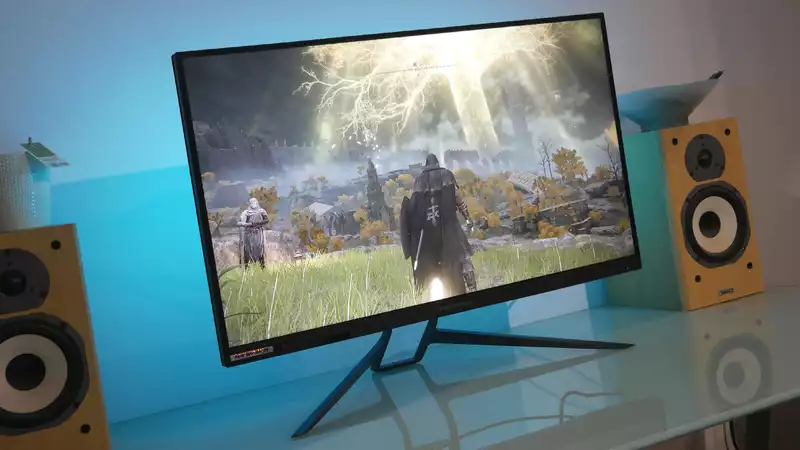Make no mistake, the Acer Predator XB3 XB323QK is one hell of a high-end gaming panel: 32", 4K, high refresh, IPS panel technology, and comprehensive connectivity including HDMI 2.1. All good things.
Sure, there are larger display options. There are faster screens with higher refresh, wider aspect ratios, and fancier display technologies, including mini-LED backlighting and, more recently, OLED panels. But whereas 27-inch 1440p has been the default choice for discerning gamers for the last decade, this 32-inch 4K with (at least) 120Hz combination is increasingly likely to be the standard for the next decade.
One might immediately question the GPU load on any 4K monitor. Indeed, to take full advantage of the Acer Predator XB3's 144Hz refresh requires a very high-end GPU. Sending out 8 million ray-traced pixels at 144 pixels per second is a formidable computational task. However, it seems almost certain that AMD and Nvidia's next-generation graphics cards will deliver about twice the performance of existing GPUs. If that happens, 4K will become all the more important.
Anyway, Acer rates the XB3's pixel response at 1ms GtG and 0.5ms MPRT, which is about as fast as current IPS technology. Brightness is 400 nits and is VESA DisplayHDR 400 certified. In other words, this is best viewed as a punchy SDR monitor rather than a true HDR panel; it is claimed to cover 90% of the DCI-P3 digital cinema color space, so color accuracy is not exactly high. However, as a gaming-centric panel, rather than for content production professionals, this should suffice.
Elsewhere, adaptive sync is supported, but there is no Nvidia G-Sync module. Connectivity includes a pair of DisplayPort 1.4 and HDMI 2.1 sockets, either of which guarantees access to at least 120Hz refresh; to display full 4K at 144Hz, the DisplayPort 1.4 socket must be used. If a lower latency and interpolated resolution is preferred, 240 Hz at 1080p is also available.
The HDMI connection also makes it a great tool for tag-teaming a PC with the latest 4K@120Hz capable consoles Acer also includes a USB Type-C connection and power delivery as well as a KVM switch The USB Type-C interface is limited to 65 watts, which is fine for a thin and light laptop, but a bit light for a true performance portable.
There is also configurable RGB LED lighting on the back of the main chassis, if you're into that sort of thing. That said, despite the slim bezel, the look is somewhat dated. Still, the gorgeous metal stand is well designed and can be adjusted for height, tilt, swivel, and rotation of all kinds.
But what about the really important part: how does this beast work? When operating in the default SDR mode, the maximum brightness is miles off the claimed 400 nits. Even with the backlight set to maximum, it is quite dull and disappointing.
To make the visuals pop, you need to toggle HDR in the Windows display properties dialog and increase the SDR brightness setting. At this point, yes, this is much better. The factory calibration tends to crush details in bright images, but the colors really sizzle, and the contrast is reasonable for an IPS monitor. More to the point, it would be preferable if the brightness could be further increased in traditional SDR mode; having to run HDR mode to make SDR content look reasonably vivid is really a bit inconvenient.
Even with the odd quirk in general picture quality, the gaming experience is the more obvious winner. For starters, the panel is probably fast enough for all but the most demanding esports addicts. Yes, who can forget the incredible speed and sharpness of Alienware's new and only slightly more expensive OLED monitors? But as far as IPS panels go, the Acer Predator XB3 is the best. Incidentally, the OSD menu offers two levels of pixel overdrive. The quickest setting produces obvious and ugly overshoot, while the "standard" mode produces good results with little blurriness.
Of course, 144Hz refresh allows for fluid, low-latency gameplay if you have a GPU capable of driving all 8 million pixels. Speaking of which, the stunning visual detail that native 4K resolution brings never gets old; don't let anyone tell you it's not a significant step up from 1440p. It really is. And remember, with next-generation GPUs due later this year, it should become more realistic to exceed 100 fps at 4K in demanding games.
As upscaling technologies like Nvidia's DLS and AMD's FSR improve, this trend will only intensify. Once you see something like Cyberpunk 2077 running at 4K ray tracing on a high quality IPS panel, you won't be able to go back to 1440p, let alone 1080p. It should be noted that Alienware's OLED panels can't compare to the detail and pixel density offered here.
All of this makes it difficult to evaluate the Acer Predator XB3 overall. The slightly problematic SDR settings are undeniably off-putting, especially given that the XB3 occupies a fairly expensive price point. We had hoped that this type of monitor would fall under $1,000 (£1,000). But now many of these products are expensive. But the overall feature set, including the gaming experience and USB Type-C connectivity, is fantastic. With just a little firmware tweaking, this monitor will be a truly great monitor. I have high hopes for it.
.

Comments